





Since October is the month to be celebrating mutants and monsters, I thought I would discuss one of my favorite mutants: the variegated plants. Collecting and growing variegated plants may be a fad for some and an obsession for others. But the demand and popularity for these botanical variants certainly seems to be growing all the time. This article is an introduction to some forms of variegation along with examples of the variegation possibilities in cultivation; of course with emphasis on my favorite plant types.
Since I became interested in "weird" plants, I have also been fascinated by the variations in these weird plants. One of the most popular focuses of plant obsession and collection is on variegated plants. As if the plants I grow and collect weren't weird enough, there are many people whose craving for unique and rare things creates within them a strong passion for oddball stuff like variegated plants. I know have my own collection of variegated plants as well and have often wondered about the reasons for this peculiar and wonderful mutation. So I researched variegation in plants and decided to compile some of the information into an article on plant variegation for Davesgarden.
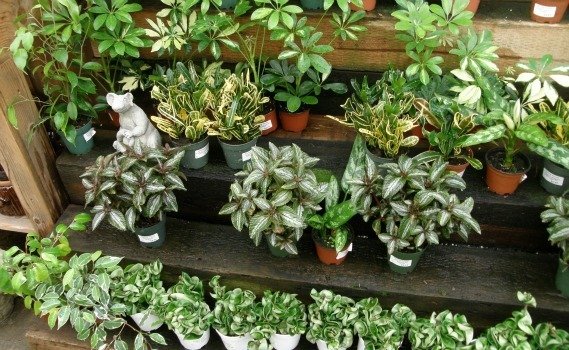
If you go to just about any nursery today, you will see dozens and dozens of variegated plants for sale (as above); they are obviously popular and are important economic cultivars for the nursery trade.
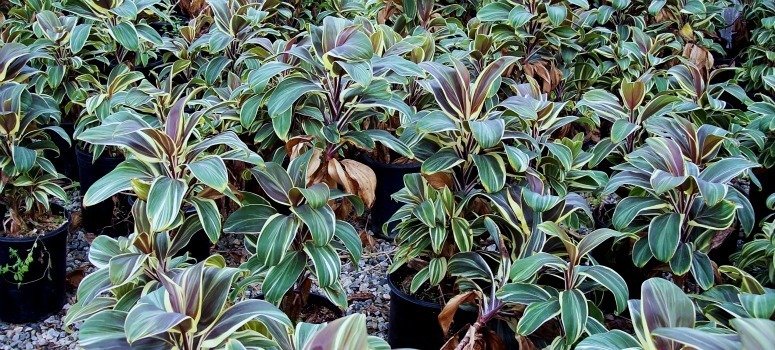
Just one of hundreds of cultivated Ti Plants (this one called Ms. Andrea) for sale in nurseries showing mutational variegation
Variegation simply refers to a variety of color, usually of a leaf or flower, but stems/trunk, branches and even seeds can be variegated as well. In most cases, the cause of the variegation is difference in the amount of pigment (often chlorophyll) in the plant's structure, anywhere from a total lack, resulting in white to pale yellow coloration (depending on the quantity of the xanthophyllic pigments in the leaf--those without any xanthophyllic contribution will be completely white), to a subtle difference, resulting in various shades of green or another color if another chemical coloration is involved. Plants with petals, carpals or leaves that have multiple colors, even if none are white, are still called variegated. Sometimes the variegation is only a variation in the amount of anthocyanins (usually the basis for most red, purple or pink coloration) and there is no lack of chloroplast output. And sometimes it is a combination of both, as one can see in the incredible variation of colors in the bromeliads, Coleus cultivars and Huechera varieties.
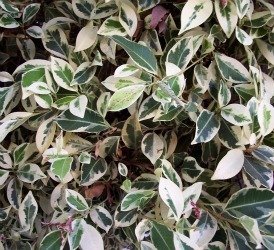
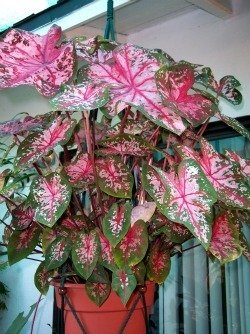
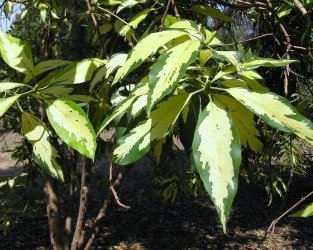
Typical variegation in Ficus microcarpus on left but this Caladium on right is also variegated with colors (rmiddle) and Lophostemon confertus variegated (far right or below)
The term variegation is applied somewhat loosely. In some cases it includes plants that are all one color, but that color is lacking in chlorophyl compared to the normal plant. These plants are also referred to as xanthophyllic when they have only the yellow coloration remaining. Completely white plants (leucocystic or albino) are rarer and often do not survive this degree of color loss.
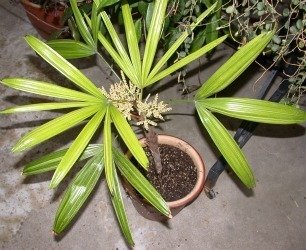
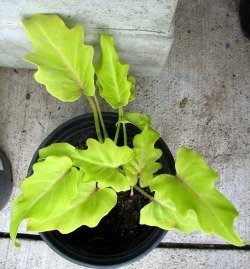
Rhapis excelsa 'Ayantishiki' is a completely yellow form of Rhapis (left) and Philodendron 'Xanadu Gold' is also. These plants are not literally variegated as they have no variety of variation in their foliage color. Yet they are still referred to as variegated plants.
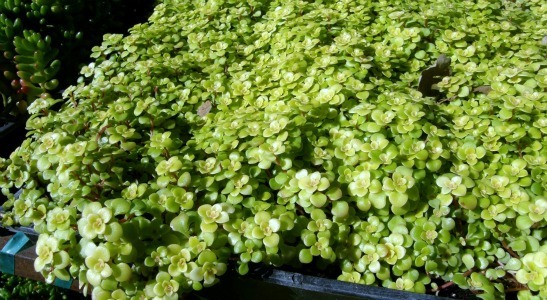 Sedum 'Ogon' is a completely yellow variegate
Sedum 'Ogon' is a completely yellow variegate
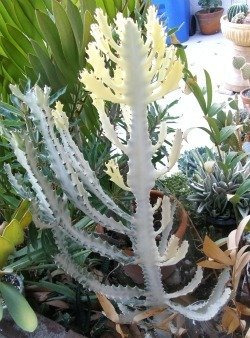 Euphorbia lactea 'Ghost' can sometimes border on being a completely albino plant
Euphorbia lactea 'Ghost' can sometimes border on being a completely albino plant
Forms of Variegation:
The causes of variegation in plants are several. The most common cause in naturally grown plants is genetic, though naturally variegated plants are for the most part uncommon. In the genera Euphorbia and Sansevieria there are a large number of naturally variegated plants in which the variegation is so stable that identification of the plant is often based on these variegated colorations. In these plants, the genetic material contained in the seed will breed true and all offspring will have the same or similar variegation as their parents. Further, the variegation does not appear to weaken the plant in any way nor does it even affect the plant's ability to tolerate hot, direct sunlight. However most of these plants are nearly as spectacularly variegated as the ones we are more familiar with in cultivation.
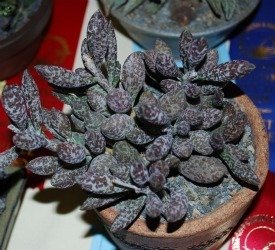
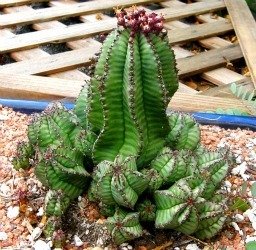
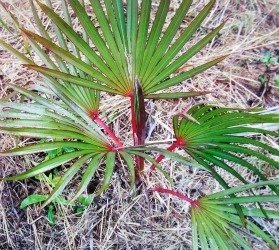
Adromischus marrianae immaculatas is naturally variegated (left) as is Euphorbia anoploa (middle). The palm on the right, or below, (Latania lontaroides or Red Latan Palm) is also variegated naturally, though it loses all this color variation with age. These species will breed true and variegation will be fairly consistent from generation to generation. Seed of these plants will germinate into all variegated individuals, as their variegation is hardwired into their DNA.
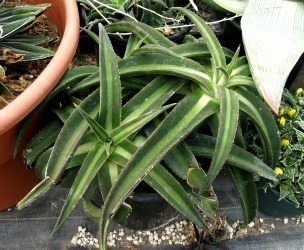
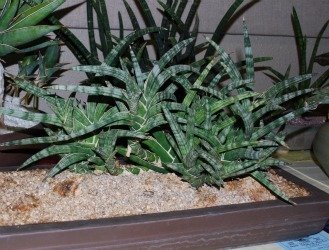
Agave nizandensis, with its "mediopicta" pale stripe down the middle is always variegated like this in nature (left ). There are several other Agave species similarly naturally variegated; Sansevieria hargesiana is one of many naturally variegated Sansevierias in nature (right )
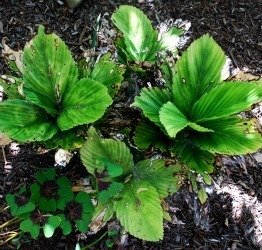
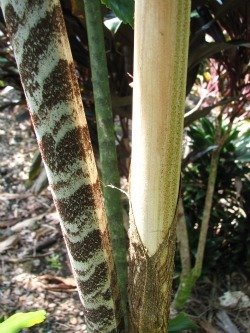
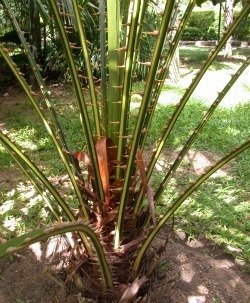
Chamaedorea tuerckheimii (the Mexican form) left is one of the few naturally variegated palm species, showing the typical splotchy light and dark variegation on its "potato-chip-like" leaves that are charactersitic of this form; middle shows a variegated petiole of another naturally variegated palm, Caryota zebrina, one of two naturally striped palms in the Caryota family (middle). Like the Caryota, the Pholidostachys palm on the right, or below, has genetically variegated petioles of yellow striping up their lengths.
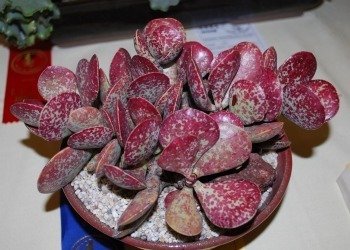
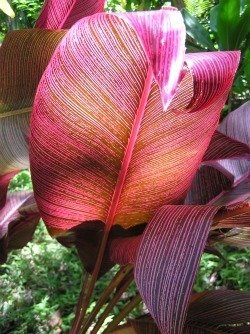
Two more of hundreds of naturally variegated species in cultivation: Adromischus triflorus (left) and Heliconia indica (right)
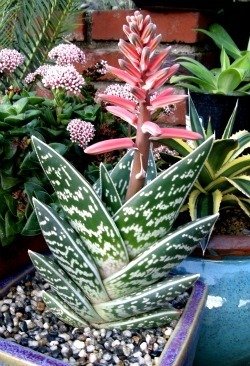
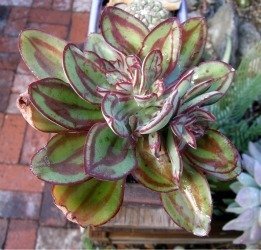
Even the name of this species of Aloe (Aloe variegata) describes its natural variegation (left); Echeveria nudicaulis is nicely and naturally variegated (right) though I am sure more the more prominently variegated clones like this one have been selected for cultivation
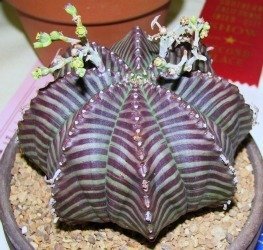
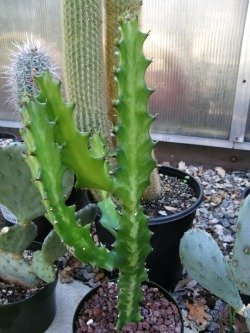
These two Euphorbias are wonderfully and genetically variegated (Euphorbia vallida on left, and Euphorbia lactea on right)
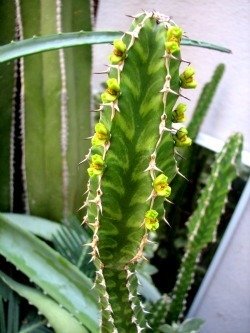
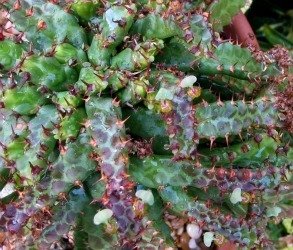
These two Euphorbias are also naturally variegated (Euphorbia pseudocactus variety on left, and Euphorbia stellata right)
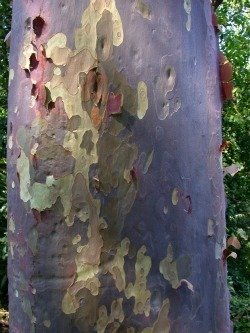
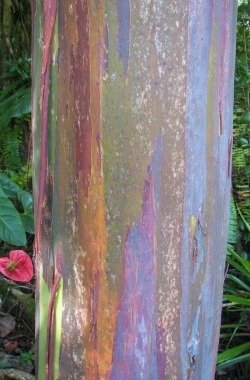
Even tree trunks can be naturally variegated. Both these Eucalyptus species are often grown specifically for their ornamental trunks (Eucalyptus maculata left and Eucalyptus deglupta right)
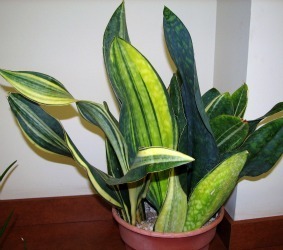
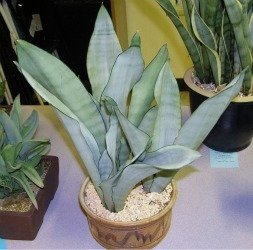
Two mutational variegated Sansevierias both of species that are naturally (genetically) variegated anyway: plant on left (Sansevieria massoniana) still shows some of its natural mottled variegation, but the mutation of striping is the variegation of interest in this plant; right is a popular Sansevieria trifasciata mutation wtihout any striping, called Sansevieria 'Moonshine'. This plant literally is nearly all one color making its designation as a variegated plant somewhat questionable, but it is the entire plant that is a different color and lacking much of its original chloroplastic influence that still makes it a variegated plant.
The most common variegation encountered in cultivated plants is not naturally genetic, however, but due to aberrant mutations in the chromosomes of the growing, or meristematic tissues. Seed from these plants will usually not germinate into another variegated plant, though in some situations, the frequency of variegation is definitely increased over the random norm. In most of these variegated cultivated plants, the variegation mutation is bred for by selecting for the best foliage or flower variants. This is done by division or other forms of vegetative propagation (such as growing new plants from stem cuttings... root cuttings will usually not result in any more variegated plants than one would encounter randomly). Many of these mutated variants are consistent from generation to generation, but others are completely random. These non-natural mutations are known as chimeras, or the combining of two different chromosomal make-ups in a single organism (in this case, cells that do not produce pigment alongside with those that do). These can be fairly consistent from leaf to leaf, or sometimes the variegation will show up randomly on the plant with some variegated leaves or branches here and none there.
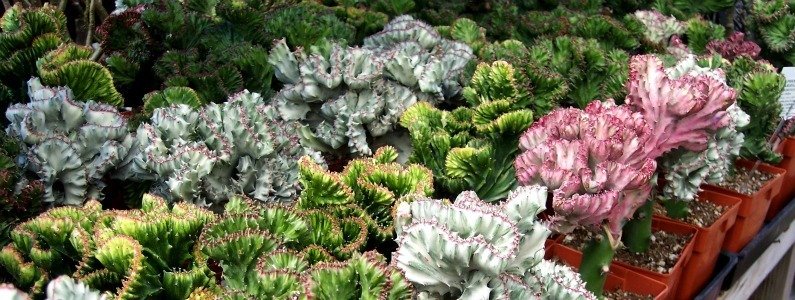
Euphorbia lactea crests showing nice variegation (both natural and mutational)
Examples of cultivated variegation in succulents (organized loosely by groups): Below are photos and some discussion of some of the more interesting varieties of variegated plants one can find in cultivation. The some exceptions, these are all mutations selected for and maintain in the nursery trade, though a few natural variegates have been thrown in.
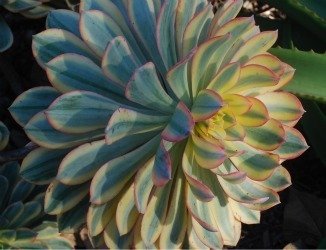
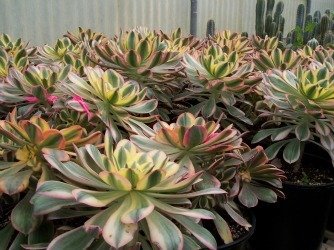
Aeonium 'Sunburst' is a very commonly and popular species of succulent that is prized for its multitude of variegated colors (above)
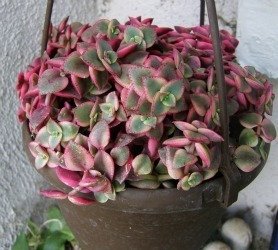
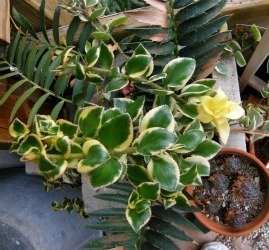
Crassula 'Calico Kitty' (left) is a popular multivariegated succulent that additionally shows seasonal variegation (not true variegation, though) with the pink colors; Crassula sarmentosa (right) is fairly common and a super easy plant to grow in the garden. I have never seen a non-variegated form of this, but I assume there is one as it is often identified with the word 'variegated'.
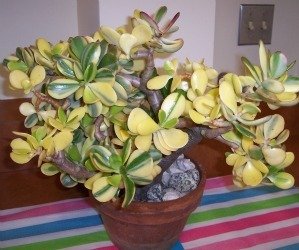
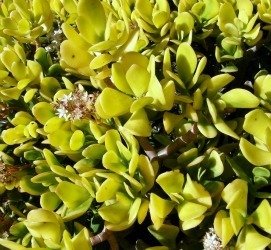
There have to be nearly a dozen or more Crassula ovata variegates available in cultivation- these are just two I have seen but have no idea what their names are, if there are any (there probably are as this is one of the most popularly grown succulents all over the US, even in climates where these don't grow outdoors)
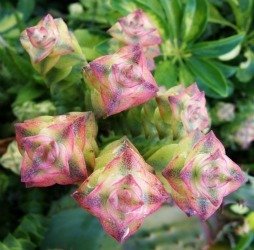
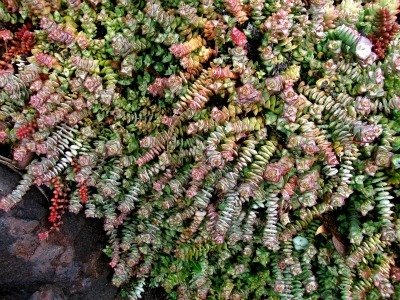
Both these Crassula perforata varieties show cultivational as well as seasonal/environmental variegation- excellent and easy plants for the garden, and tolerate full sun, even when variegated
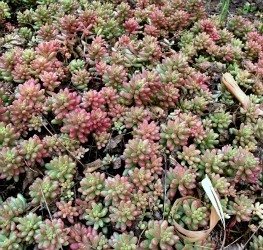
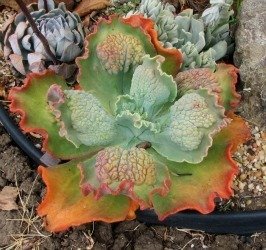
Echeveria agavoides is a naturally variegated plant, but this form is an extreme version that is cultivated for, called 'Ebony' (left); There are hundreds of Echeveria hybrids like this one with all sorts of colors and variations, some which might be considered real variegation, and some which are definitely subject to sun, temperature, water and heat/cold exposure. Hard to tell which, if any or all are going on here (right)
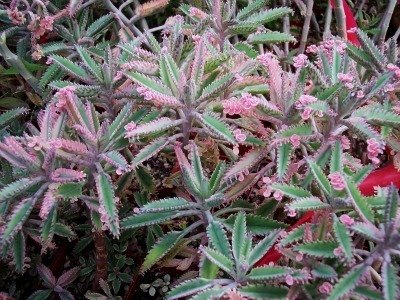
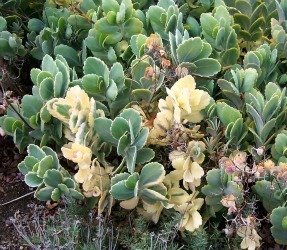
The Kalanchoe cultivar on the left (or above) is a pink version of one of the Mother of Thousands species that was cultivated specifically for the pink variegation in leaves and bulbils and reproduced specifically for that mutation; but the Kalanchoe on the right (or below) is part of a large planting at the Huntington Botanical Gardens that shows a 'natural' mutation of variegation in one small section of the colony seen as the almost purely yellow-leaved individuals.
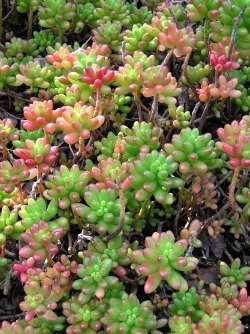

Many sedums have variegation, but these are two I grow frequently. Left is Sedum x rubrotinctum, which is green, but here showing stress variegation (what I call a form of false variegation); right is Sedum x rubrotinctum 'Aurora' where the greens are severely diminished due to lack of chloroplasts- this one, too, is showing some stress variegation, but it is also a truly variegated cultivar.
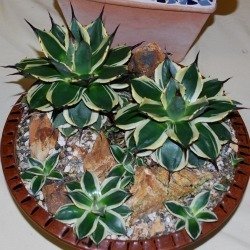
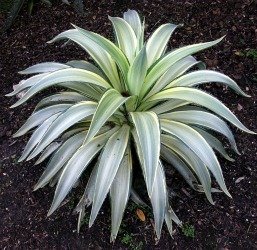
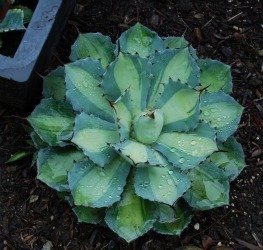
Agave pattonii variegated (left) is one of many dozens of beautifully variegated Agaves available in cultivation; Agave 'Joe Hoak' is an Agave desmetiana hybrid that has really become popular in cultivation (middle); right is one of dozens of smaller Agave potatorum variegates in cultivation, some with Japanese names since it was they that created them. Most probably do not have names, though. Very popular plants, however.
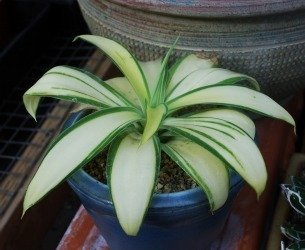
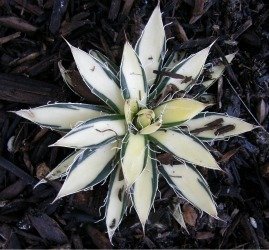
Two extremes of the "norm" of cultivated variegated Agaves: Agave attenuata on the left is a nearly albino individual, as the Agave schidigera on the right. Both of these rarer forms fetch top dollar among collectors of rare succulents and variegates. Sometimes the weaker and more albino a plant is (and the more dangerously mutated it is- less apt to survive in nature) the more it is wanted.
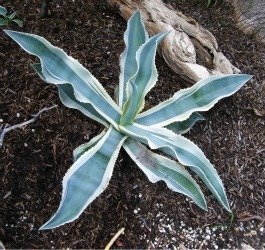
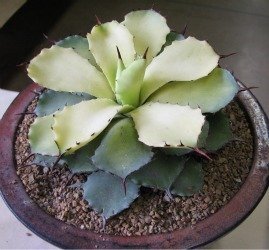
Agave gypsophila is a great looking agave to begin with, but a variegated version is quite something (and rare)- left; right is a bizzare chimera of Agave potatorum that just suddenly started producing colorless leaves
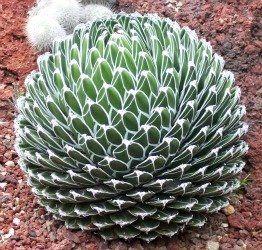
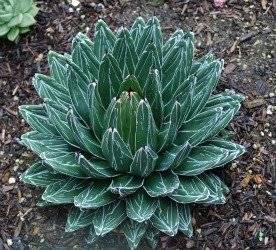
Agaves are among the most popular of all the succulent variegated plants. These two Agave victoriae-reginae plants are actually naturally variegated, showing the variations in nature of this marvelous wonder. The plant on the left is a rare form of this naturally variegated plant, and has been cultivated since specifically for its numerous narrow, thin white lines of variegation. This variegation is actually a reflective form of variegation (see below) as the white is not caused by a colored stripe within the leaf tissue itself, but is a chalky white long on the leaf surface.
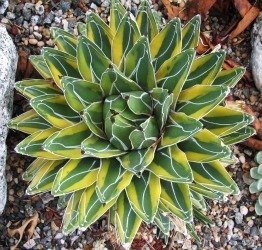
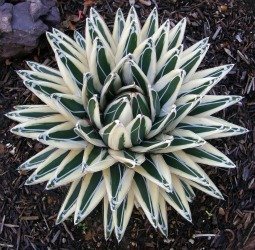
But these two variegation muations are not natural and are cultivated for furiously. The Agave victoriae-reginae mutaion on the left is called Golden Princess and is actually becoming relatively common in cultivation now, but the much rarer white variegation mutation on the right is still very rare and very very expensive
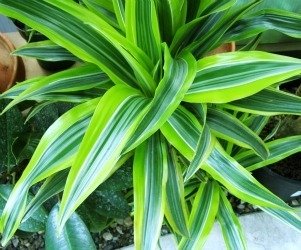
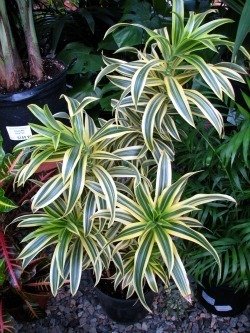
Many Dracaena cultivars are grown as indoor plants specifically for their wonderful variegation- left is Dracaena 'Lemon Lime' and right is Dracaena reflexa
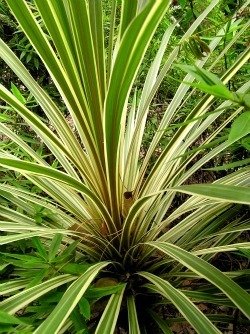
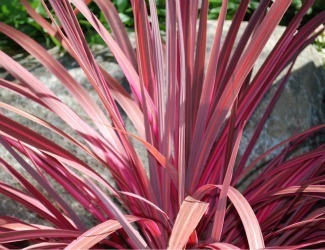
Cordylines, which are closely related to Dracaenas, also are commonly grown for their various colors and variegation (but usually grown outdoors instead of indoors)- left is a cultivar of Cordyline australis called 'Albertii'; right is Cordyline 'Electric Pink'
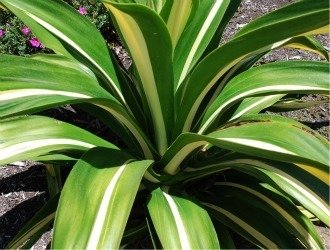
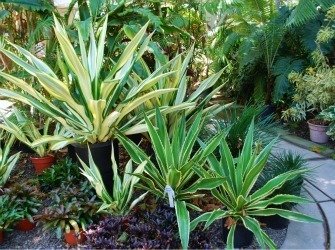
Left is a particularly nice Furcraea foetida sport and right is a grouping of variegated Furcraeas for sale at a nursery
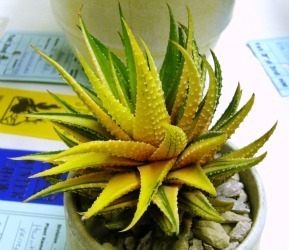
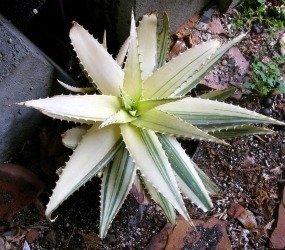
Haworthia minima (left) is just one of many many forms of variegated Haworthias in cultivation. Thanks to the incredibly active Asian collectors of small, attractive and rare succulents, there are a seemingly limitless number of variegated Haworthias on the market now. Right is an extreme version of Aloe maculata variegated, with some completely albino leaves. Aloe maculata (the Soap Aloe) is one of the most commonly available species in variegated form thanks to its being one of the most commonly grown species there are, and it is such an easy and aggessive grower. Large numbers of plants mean greater chances for mutations to occur. It is, by the way, a naturally variegated species (mottled) so perhaps that also increases the chances for variegation mutations to occur.
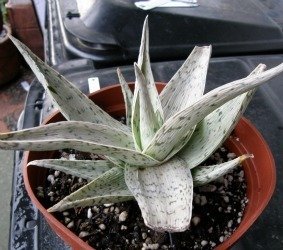
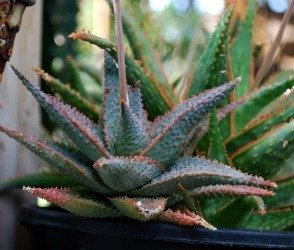
Aloe 'Doran Black' (left) and Aloe 'Spikey' (right) are both colorful hybrids- one has white, reflective variegation on a pale green background in the form of numerous longitudinal plaques, while the other has many colorful teeth and spines on its leaves.
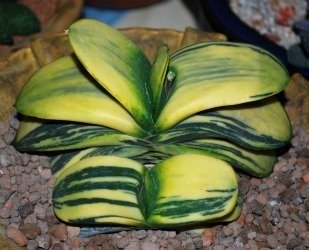
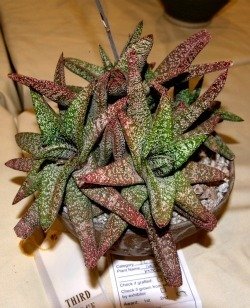
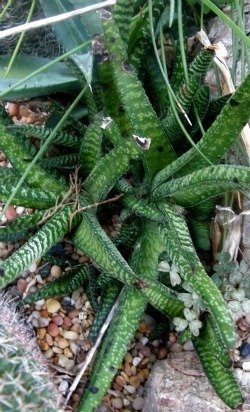
Variegated Gasterias are nearly as common and popular as are variegated Haworthia. Left is an exceptional variegate of Gasteria nitida var armstrongi; middle is a nice naturally variegated species, Gasteria batesiana, as is the Gasteria sp. unknown on the right or below.
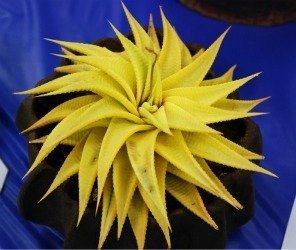
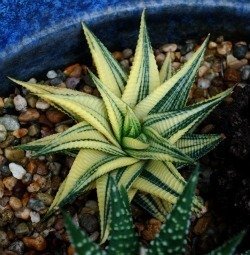
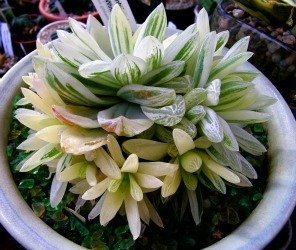
Both Haworthia limifolia (left and middle) and Haworthia cymbiformis (right or below) are commonly found in variegated forms. Haworthia cymbiformis even sports variegates frequently from normal plants you can get anywhere. The other two variegates are rarer, but both these are exceptionally nice forms and extremely rare.
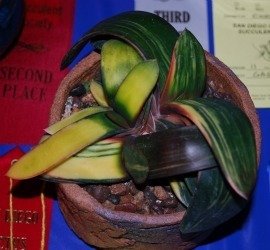
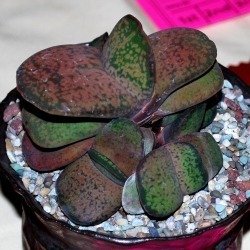
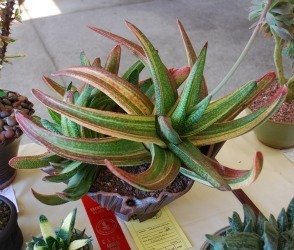
Three more nicely variegated Gasterias... one in center is a naturally variegated plant, but two at either end are chance mutations and exceptional plants
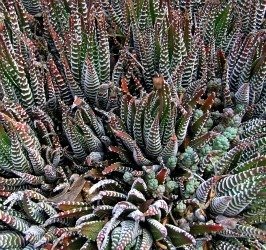
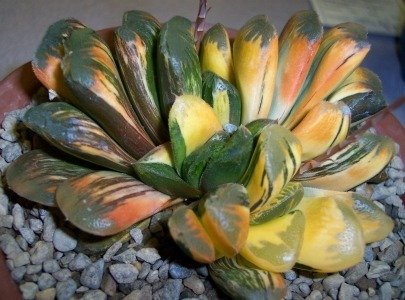
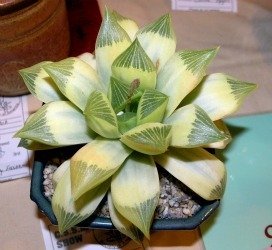
Haworthia attenuata is a naturally variegated and striking plant (left), so variegates of it are even more amazing (center); right pr below is another nearly colorless Haworthia
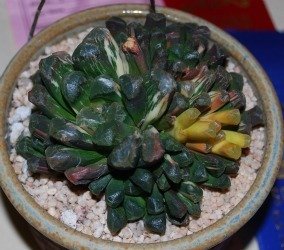

among the most popular and usual are the Haworthia truncata var. maughanii variegates- these are typically a bit difficult to keep alive, very slow growing yet amazing sometimes
Euphorbia Variegates
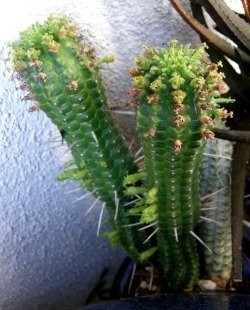
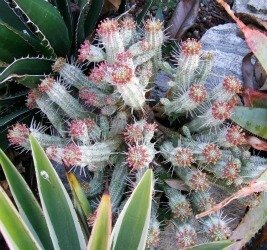
Euphorbia mammillaris is a fairly common plant in cultivation, but its variegated form (right) is far more common due to its more interesting and unusual coloration
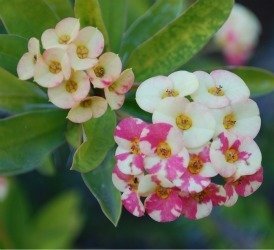
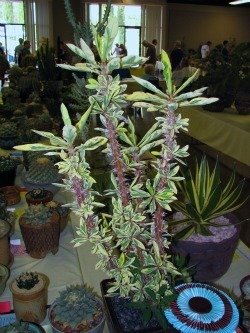
Left is a Euphorbia ambohipotsiensis cultivar showing some floral varietation, and this related species, Euphorbia millii (aka Crown of Thorns), right is showing unsual variegated foliage
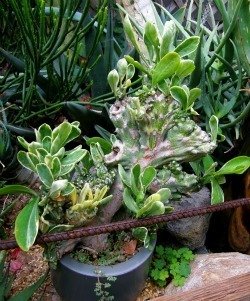
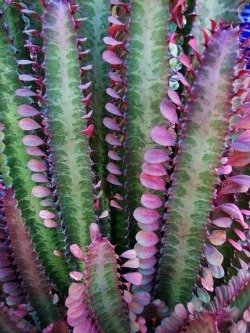
left is a cristate and variegated Euphorbia nerifolia, which for some reason is not that rare a mutation or combination of mutations; right is a Euphorbia trigona 'Rubra' showing natural, stress and a mutational pigmentary variegation all at the same time
Variegated Palm and Cycad cultivars:
In one of my favorite plant families (the palms), almost all the variegated plants are random freaks and the yellow leaf tissues appear to be very sun sensitive (most burn quickly and develop necrotic brown sections in their foliage eventually). However Caryota mitis (suckering Fishtail Palm) variegated is an exception to this situation and is able to survive sun seemingly as well as its green counterpart. And it is nearly equally as fast and robust a plant. A few other species of palms have natural variegation (genetic) and of course then the variegation is not a weak point. And one of the most beautiful palms in the world, Licuala 'Mapu', is a variegated species that is indeed a collector's item. It too is somewhat sun sensitive, but then so is the 'normal' form of the plant (though less so). In one of my other favorite groups of plants, the cycads, nearly all are extremely sun sensitive and most tend to looks sick or unhappy unless well-protected from direct sunlight.
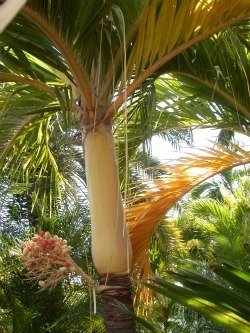
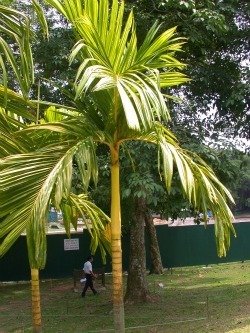
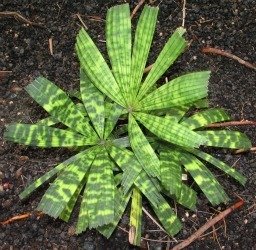
This striking variegated form of Adonidia merrilli is quite rare and prized (left); middle is a relatively healthy example of Areca catechu (Beetle Nut Palm). Both are growing in some direct sun but in very tropical climates so their foliage is not being destroyed by the radiation. Right is Licuala 'Mapu', one of the most sought after variegated palms and one that seems to breed true.
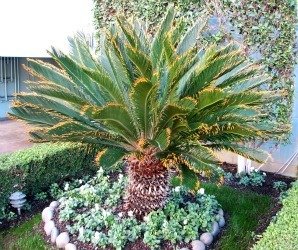
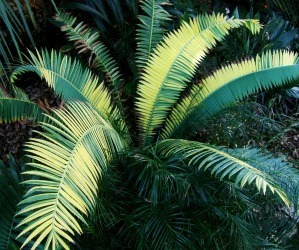
The Cycas revoluta on the left has variegated leaflet tips (one of the more common variegated cycad forms), but these chlorophyll deprived leaflet tips have no ability to tolerate sunshine, so the variegation quickly turns to brown (necrosis) when grown in sunshine; The Dioon spinulosum on the right (much rarer mutation) is being kept carefully in shade to avoid the same necrotic changes of its wonderfully variegated leaves.
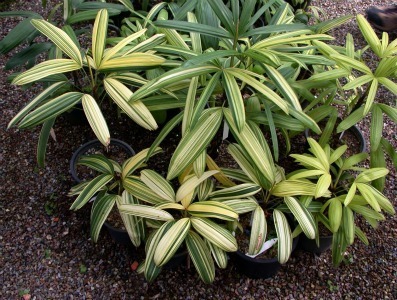
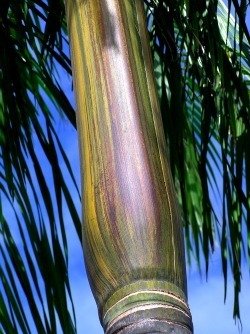
These variegated Rhapis excelsas and subtilis on the left show remarkable striping and are highly prized among collectors; left shows a variegated crownshaft on a Euterpe precatoria. Only the crownshaft is variegated in this mutation. Right (or below) is an apparently very rare mutation of Chamaerops humilis (Mediterranean Fan Palm) that has been unofficially named 'Goldstripe'. Even the seeds and petioles of this palm are variegated. The yellow sections of the leaves that get exposed heavily to the hot, southern California sun get fried pretty badly, though.
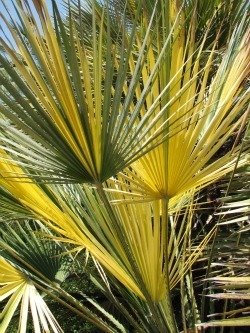
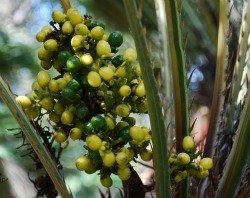
Chamaerops humilis variegated is an extremely rare mutation (this was name 'Goldstripe' by the Huntington, but I am not sure that is an official name). Even the seed and petioles of this plant are variegated.
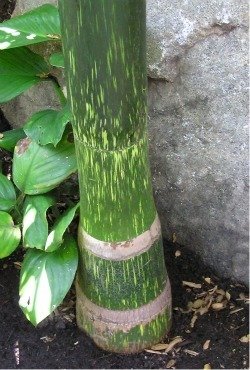
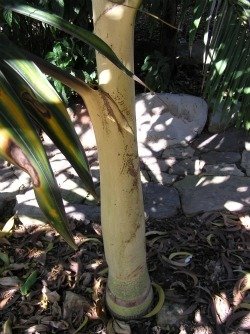
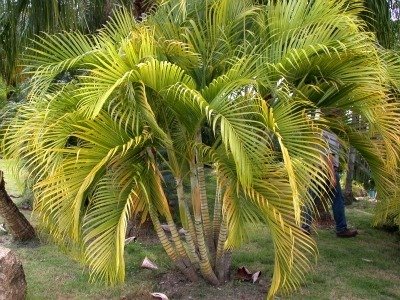
Chambeyronia macrocarpa has some natural variation in nature, but the palm nurserymen have gone ahead and named a few of these variegated variations and made them their own now. Left photo is of a Chambeyronia 'Watermelon' and the middle is of Chambeyronia var. hookeri. Both variegations only involve the trunk and crownshaft- the leaves are still the same as ever. Right (or below) is a rare variegated (though the plant is completely yellow, so is it still 'variegated'?) of Dypsis lutescens, or the common Areca Palm or Butterfly Palm.
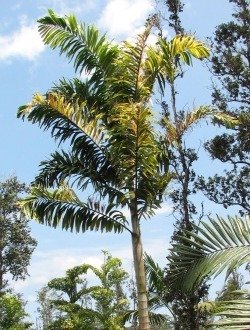
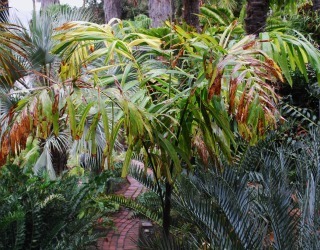
Left is a hybrid palm called Foxy Lady (Veitchia x Wodyetia) that is also variegated- in the tropics these palms are simply fantastic. But in southern California, these really struggle with the dry, hot sun (right) and almost all areas of variegation become quickly necrotic (brown and dead).
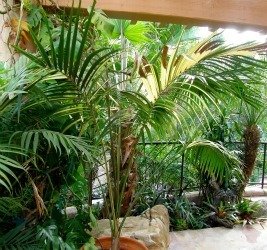
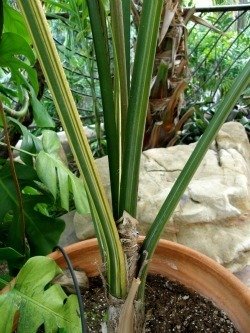
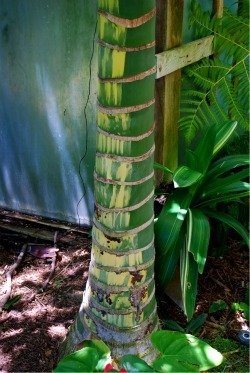
Howea forsteriana (Kentia Palms) are frequently found to be variegated (presumably as they are grown in such massive numbers for the indoor plant industry, a mutation here and there is not surprising). But these really suffer in sunlight- best to keep these rare palms in deeper shade. Palm on right even shows true variegation along one side of its trunk.
Cultivated Variegated Cacti
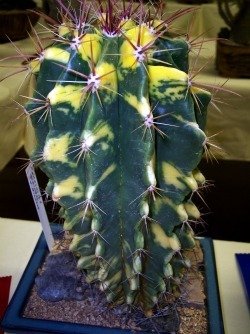
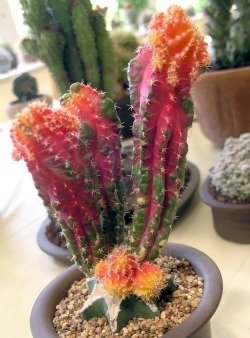
left is a nice variegated Ferocactus stainsii; right is a chimera and grafted form of Gymnocalycium (probably mihanovichii)
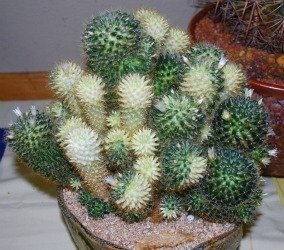
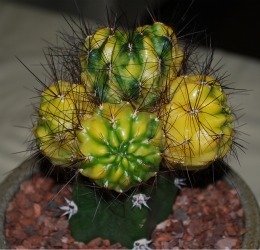
Mammillaria crinita variegate (left) showing some completely albino columns; right is a grafted Rebutia polymorpha. Many variegates are weak and can only survive if grafted onto a healthy normal plant.
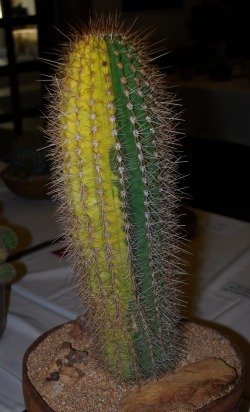
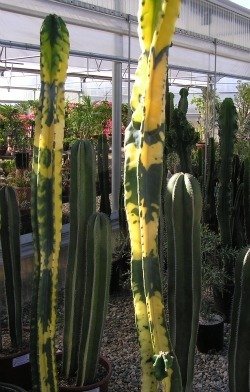
Echinocereus poco (left) showing chimeric split down the middle; right are some Cereus sp. showing haphazard variegation
Variegated Grasses and Bamboos
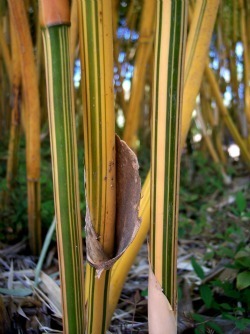
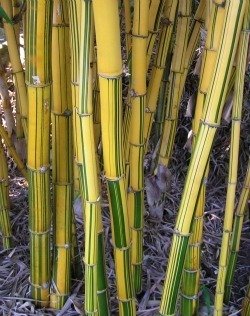
there are many variegated bamboo, though I personally only have experience with a few (Bambusa multiplex 'Alphonse Karr', left, and Bambusa vulgaris 'Vitatta' right). Both are surprisingly tolerant of full sun and the variegation is fantastic
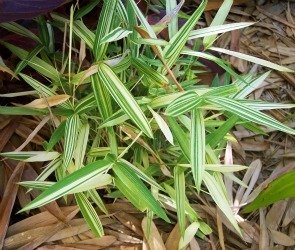
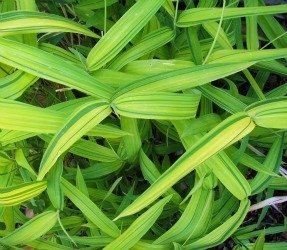
These Pleioblastis species are a bit more light sensitive, but still are pretty hardy in the garden
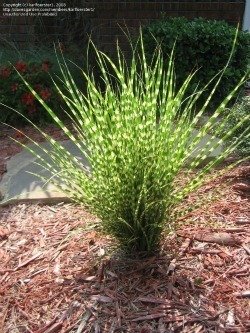 There are a variety of variegated grasses, but this certainly is not my area of expertise. This Tiger Grass (Miscanthus sinensis 'Gold Bar') was photographed by karlfoerester1.
There are a variety of variegated grasses, but this certainly is not my area of expertise. This Tiger Grass (Miscanthus sinensis 'Gold Bar') was photographed by karlfoerester1.
Bromeliads in Cultivation
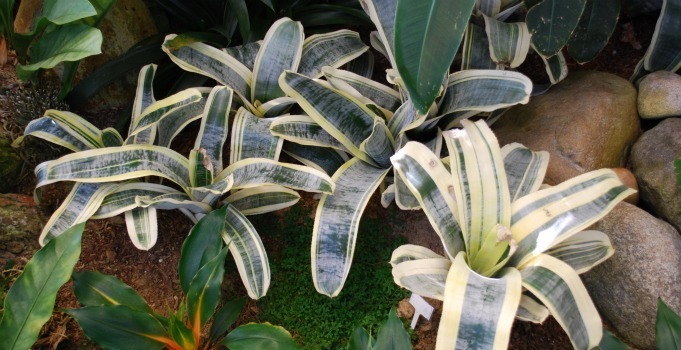
Aechmea fasciata 'Laurens' in a greenhouse showing amazing variegation
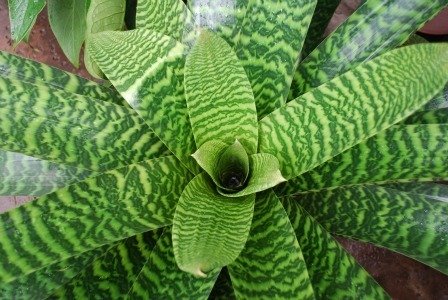
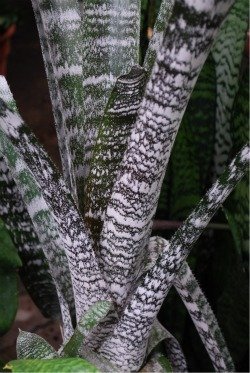
Vriesea xerographica is a classic complexely variegated bromeliad, though not sure this is a cultivar... might be a natural (left); right is Hohenbergia 'Fudge Ripple'
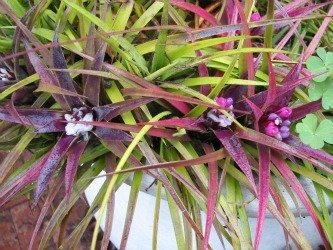
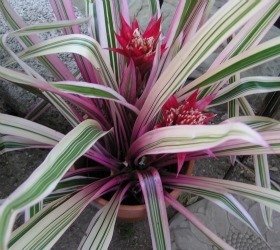
Aechmea recurvata benrathii in my yard (left) and an unknown cultivated variegate in a local nursery (right). The variety of colors and variegations in the bromeliad world is seemingly endless
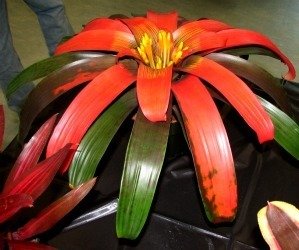
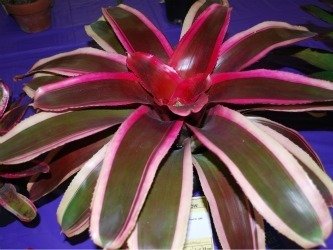
Several Neoregelia cultivars showing more amazing colors and variegation
Various Dicot Variegated Plants
There are literally thousands of these and there is not way I can even approach covering this topic other than to show a small smattering of plants I have personally photographed, and in a few cases, grown myself. However, my favorite plants are invariably included in the monocots shown above so I apologize for not giving this category more emphasis. It would make the article impossibly long, though.
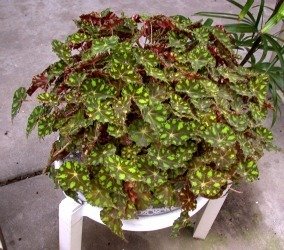
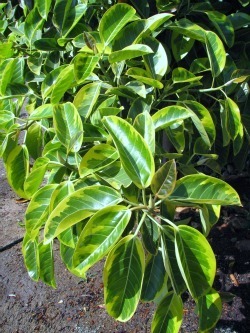
There are hundreds of Begonia cultivars and many, if not most, are variegated. This one is called Begonia 'Kit Kat' (left); right is a relatively rare example of a full sun variegated plant (a variegated Ficus or Fig species). Most variegated shrubs and smaller trees are relagated to the shade or as a house plant, but some do make excellent landscaping subjects. When one goes into a nursery and sees the relatively large proportion of variegated plants for sale, one may later notice when driving through particularly nicely landscaped neighborhoods how rare variegated plants really are in outdoor, sunny situations.
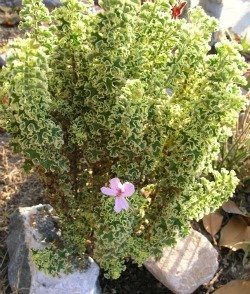
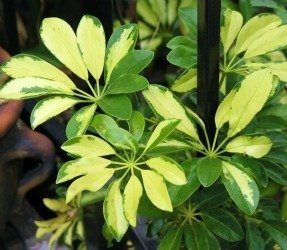
Both the above plants are variegates growing in my yard, and two that tolerate full sun, even in inland southern California. Left is a French Lace Geranium (Pelargonium crispum 'French Lace') and right is a variegated Schefflera arbicola (a common house plant, too).
Changes and Extremes of Culitvated Variegated Plants:
Because this form of variegation is not hard-wired genetically, often ‘reversions' can take place, where parts of the plants will develop the original, non-variegated coloration, or offsets will be normal and non-variegated. For those wishing to preserve the variegation, these reversions are usually quickly cut off or otherwise removed.
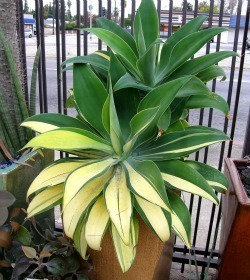
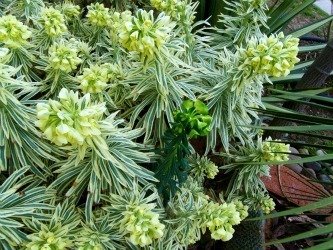
Left is a nice Agave attenuata variegate that has put off a healthy normal reversion (the totally green rosette). Many Agave attenuata variegates sucker normally color plants and these may outcompete the variegated sucker for energy, so normally these are removed except for in somewhat artistic purpuses as in this potted planting; the Euphorbia characias 'Tasmanian Tiger' in my garden shot out this deep green normal colored branch after a few years of being 100% variegated and this is a typical example of a reversion.
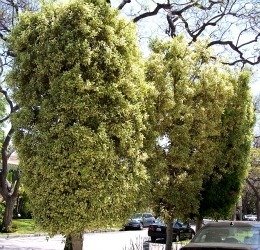
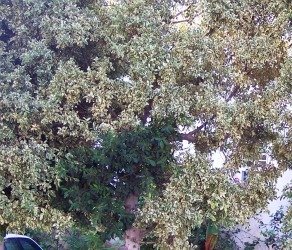
This is a Ficus microcarpa planting in Los Angeles of a variegated cultivar showing a 'blemish' or reversion near the trunk of the third tree (left) and in center of tree on right
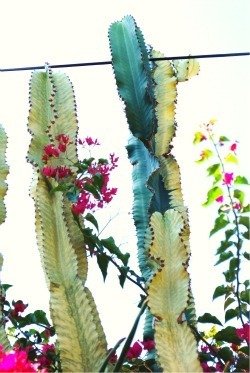
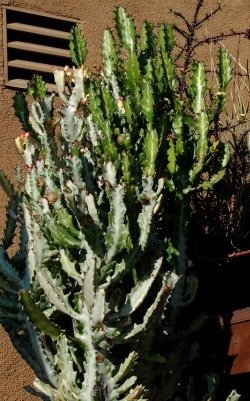
This reversion (left) occured in my own plant (Euphorbia ammak). Until this happened, I was not even sure Euphorbia ammaks weren't all variegated and that perhaps the variegated form (which is virtually the only form offered in cultivation) was perhaps a genetic and natural mutation, not a cultivation mutation. The Euphorbia lactea 'Ghost' on the right is reverting back to its original coloration (which just also happens to be variegated, but genetically)
On the other hand, sometimes of these variegated plants can produce offshoots or suckers that are completely devoid of any chloroplasts at all resulting in a nearly pure white or pale yellow plant or plant part. Generally albino parts will not look great for long, unless these plants are very well protected, as the colorless tissues are so susceptible to sunlight. And white offsets will rarely even live long enough to produce many leaves as they cannot produce their own energy for sustaining life... but, if they are still feeding off the mother plant, sometimes one can grow a nearly completely white (albino) plant.
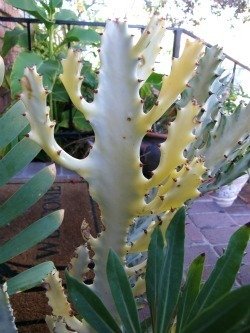
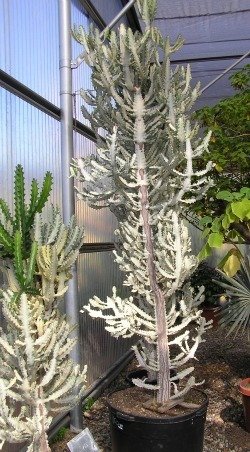
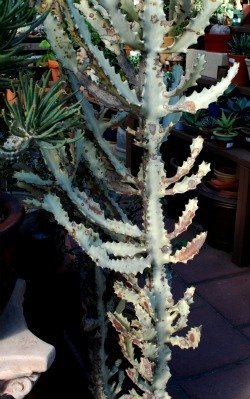
These Euphorbia lactea 'Ghost' albinos are amazing tolerant of sun (don't like desert full sun) and are very popular in cultivation. A large specimen like the one on the right is a very costly and prized plant, though; right is a larger specimen that has been sun burned badly (see brown necrotic spots)
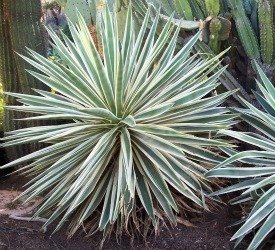
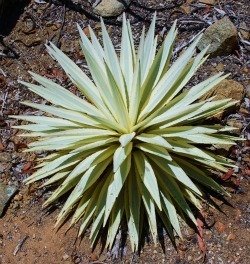
Most Agave angustifolias in cultivation are variegated like the plant on the left, but some sports are grown like this near albino on the right, known as Agave angustifolia 'Woodrow'. This nearly chlorphylless plant is actually amazing tolerant of sunshine.
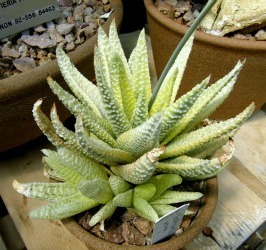

More nearly albino plants: The Haworthia cymbiformis in these pots on the left are actually very common mutations off normal plants; right is a rare nearly albino Gastwarthia (intergeneric hybrid) 'Royal Highness'.
In general variegated plants tend to be weaker than their non-variegated counterparts thanks to their lessened ability to carry out photosynthesis (due to lack of chlorophyll). However, most of these plants are in somewhat artificially controlled environments and grown specifically to survive in a pampered, cultivated situations where competition is relatively non-existent, and shade and fertilizers, if needed, are often provided. In some of the variegated succulents I have grown I personally do not see much of a weakened condition and many of these plants seem as able to survive environmental extremes as well as their ‘normal' versions can.... Though they do tend to grow a bit slower on the average. This weakness is taken to an extreme, often, with the albino forms of variegation, with some not making it past their first few leaves.
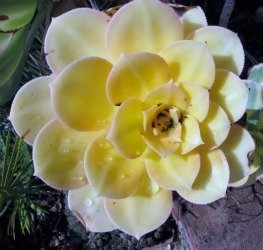
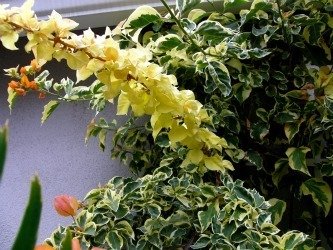
left is a completely albine rosette of a variegated Aeonium, Aeonium 'Sunburst'. Note that it is burning in the sun (black spots). Eventually this branch burned so badly it died and had to be cut off the main plant, which also suffered somewhat in the extreme heat and sun it was being grown in; right shows an ablino branch of an already variegated Bougainvillea 'Orange Ice'. This albino branches tend to burn in the sunshine, though, lose all their leaves and then the entire branch will often die.
Patterns of Variegation:
These cultivated variegations come in different patterns, some which have descriptive names. For example leaves that a stripe of variegation down the center are usually referred to as "mediopicta," while those with a green stripe or stripes in the middle and the borders are variegated are "marginata." Those having pure white margins sometimes called "albo-marginata" while those with yellow margins are sometimes called "flavomarginata" or "aureomarginata" (actually means gold edged). Lineata or striata describes thinner linear patterns of different colors along the length of the leaves. Leaves with two, three or four colors are sometimes called "bicolor," "tricolor" or "quadicolor." Almost all these names refer to variegated plants that are monocots. This is because monocots tend to grow their leaves from a center point (bromeliads, agaves, palms, Draecenas, Haworthias etc.) and so the patterns almost always are linear and run the length of the leaves.
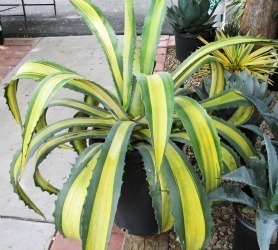
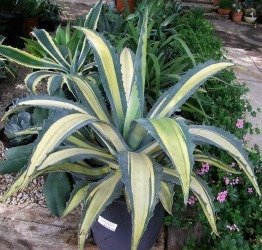
Two versions of Agave americana mediopicta, one with yellow (aureo-mediopicta) and white (albo-mediopicta)
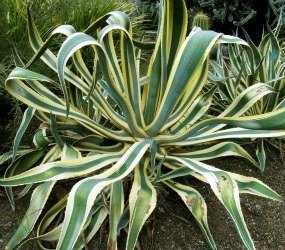
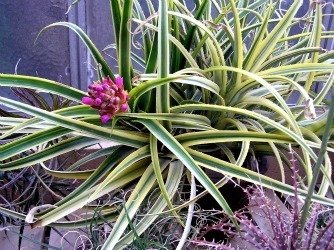
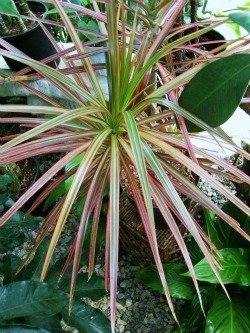
Three marginated variegated plants: Agave americana marginata (left), Aechmea recurvata marginata (middle)and Dracaena marginata (right)
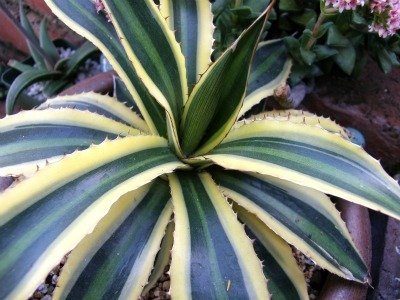
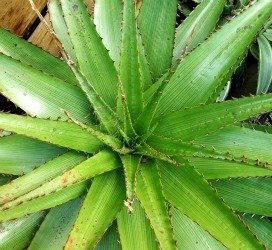
Agave lophantha 'Quadricolor' (left) and Aloe lineata (a naturally variegated plant) right
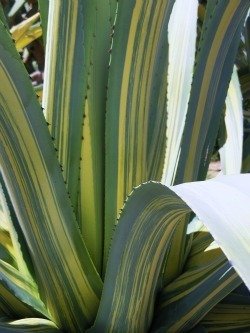
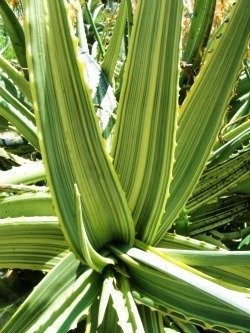
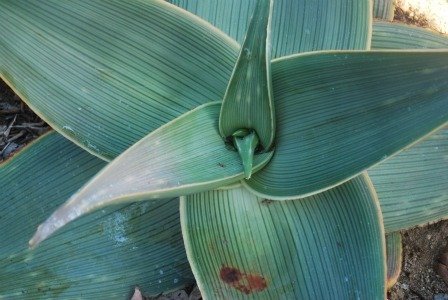
Agave americana striata (left) and a striatedly variegated form of Aloe camperi (middle or right) . This variegated form of Aloe camperi is not officially described, but if it were, lineata or striata would be good choices. On the right (or below) is Aloe karasbergensis, which is linearly variegated naturally (this is a permanent genetic variegaton) and usually is not remarked upon in its name because of that is just the way it is.
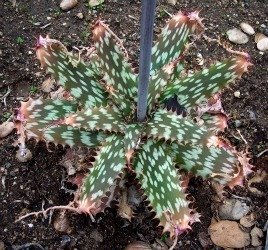
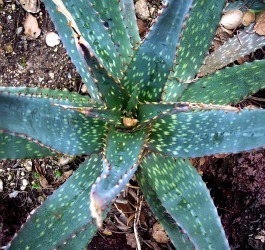

Both plants above are Aloe greatheadii and both are genetically/permanently variegated. These would be labeled as mottled, or spotted, but you can see how limiting that is as their spots or mottling differ from plant to plant. I like to use words such as linearly spotted, group mottling etc... but those are simply made up terms. The third Aloe is Aloe esculenta, which is showing more of a speckled form of variegation
Dicots, on the other hand, do not grow leaves from a center point so their variegation patterns tend more to be variable including mottling or circular patterns somewhat mimicking the shape of the leaf. There are still numerous marginated leaf patterns, but I know of no names for most of these other dicotyledonous variegation patterns, but I would not doubt there are some. Plants with yellow margins or striping are named just as they are above in the monocot variegates. Most dicot plants with mottled, splotchy or variable variegation patterns are just called ‘variegata'.
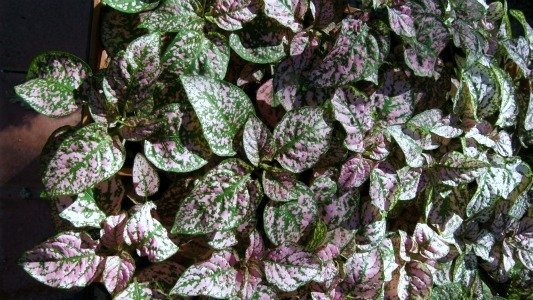
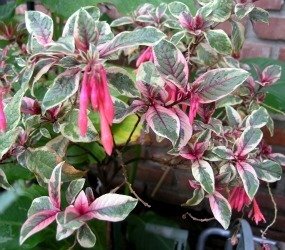
This dicot plant, known as the Pink Polk-Dot Plant (Hypoestes phyllostachya), is mottled, too very irregularly and quite randomly (left); the Fuchsia 'Firecracker' on right has relatively random variegation as well
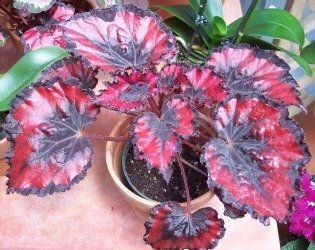
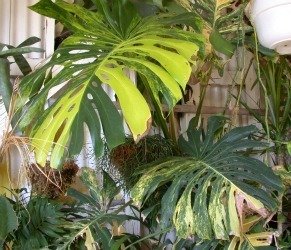
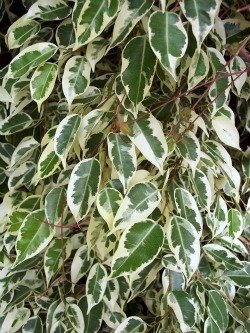
These patterns, as far as I know, are not specifically named (Begonia Rex Contorum variety on left and Monstera deliciosa aureo-variegated -middle, Ficus microcarpa on right or below)
Other forms of variegation:
Venal varigation is visible on plants that have prominent veins that are generally chloroplast-free (as many veins are, but most are not so prominent as one would be tempting to label those leaves as variegated).
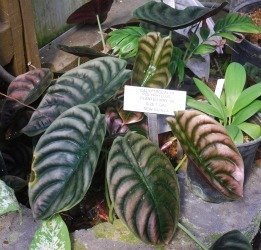
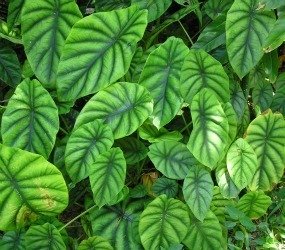
These two forms of Alocasia cuprea are markedly variegated along their veins which makes them such striking and collectable plants
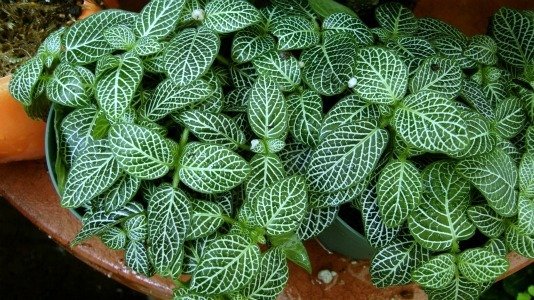
This Fittonia albivenis variety or Miniature Mosaic Plant is wonderfully venally variegated
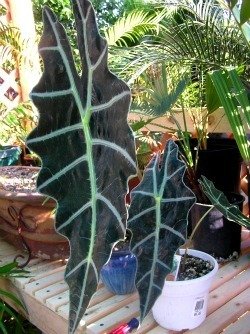
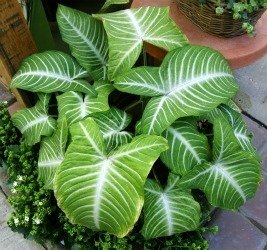
Alocasia amazonica (left) and Xanthosoma lindenii (right) have striking venal variegation as well
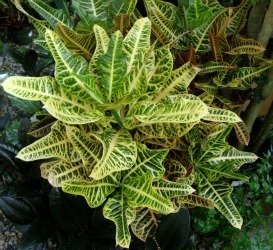
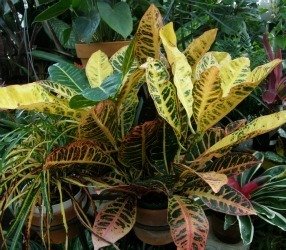
These Crotons are more excellent examples of variegated plants with venal variegation
Reflective variegation is cause by shiny or otherwise reflective material on the leaf surface itself rather than a chlorplast deficiency chimera within the makeup of the foliage (as is the case in most Begonia variegations).
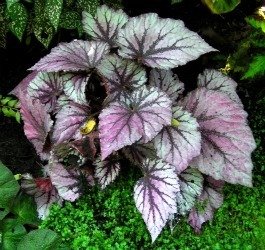
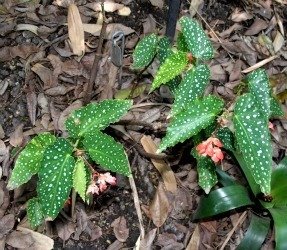

All three of these Begonia cultivars show examples of reflective variegation
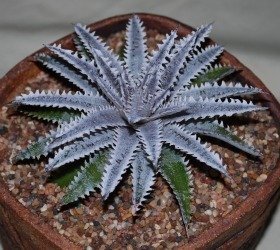
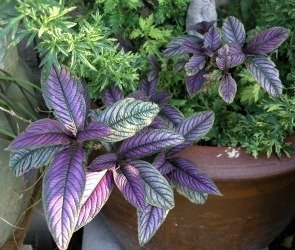
The Dyckia cultivar on the left some would argue is not variegated, but it has reflective coating on the newer leaves that vary the color of the leaves; Strobilanthes (right) shows both venal and reflective variegation
Pigmentary variegation has been briefly discussed above and this is due mostly to the variable presence of phytopigments (anthocyanins are the most common) in the plant's leaves resulting in a variety of colors aside from just white or pale yellow in a seemingly infinite number of patterns (as seen in Coleus cultivars).
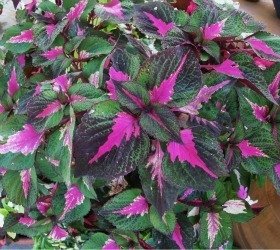
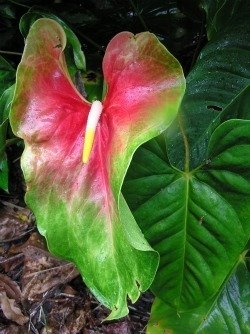
two varieties of Coleus with amazing pigmentation variegation

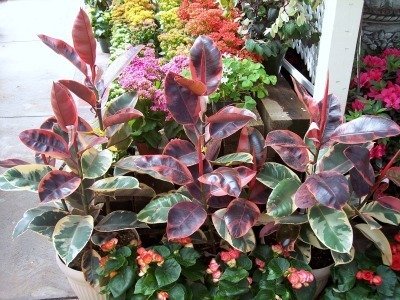
The Anthurium 'Obake' is a nicely variegated plant thanks to its pigments (left); This form of Ficus elastica also shows some pigmentary variegation along with the normal variegation it is known for
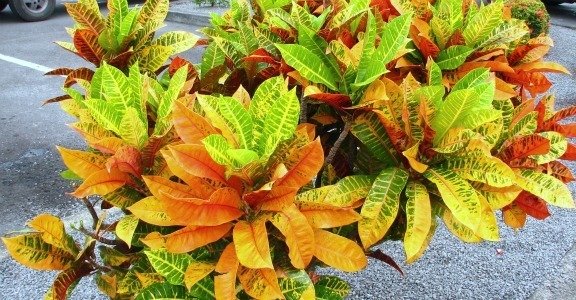 This croton shows both venal and pigmentary variegation
This croton shows both venal and pigmentary variegation
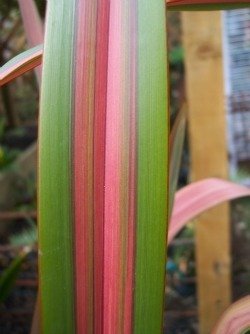
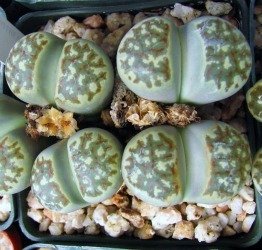
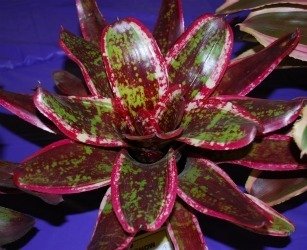
More examples of pigmentary variegation- the flax (Phormium tenax 'Jasper') on left; Lithos leslie (center) and the bromeliad, Neoregelia variety on right or below
There are also some viral variegations; some benign and constant, and some possibly not benign but also inconstant. Some of the Camellias are cultivated and even named specifically for the viral variegation they show in their flowers. Reportedly of the approximately three thousand cultivars of Camellias, almost twenty five percent have some viral variegation in them.&
Copyright © www.100flowers.win Botanic Garden All Rights Reserved